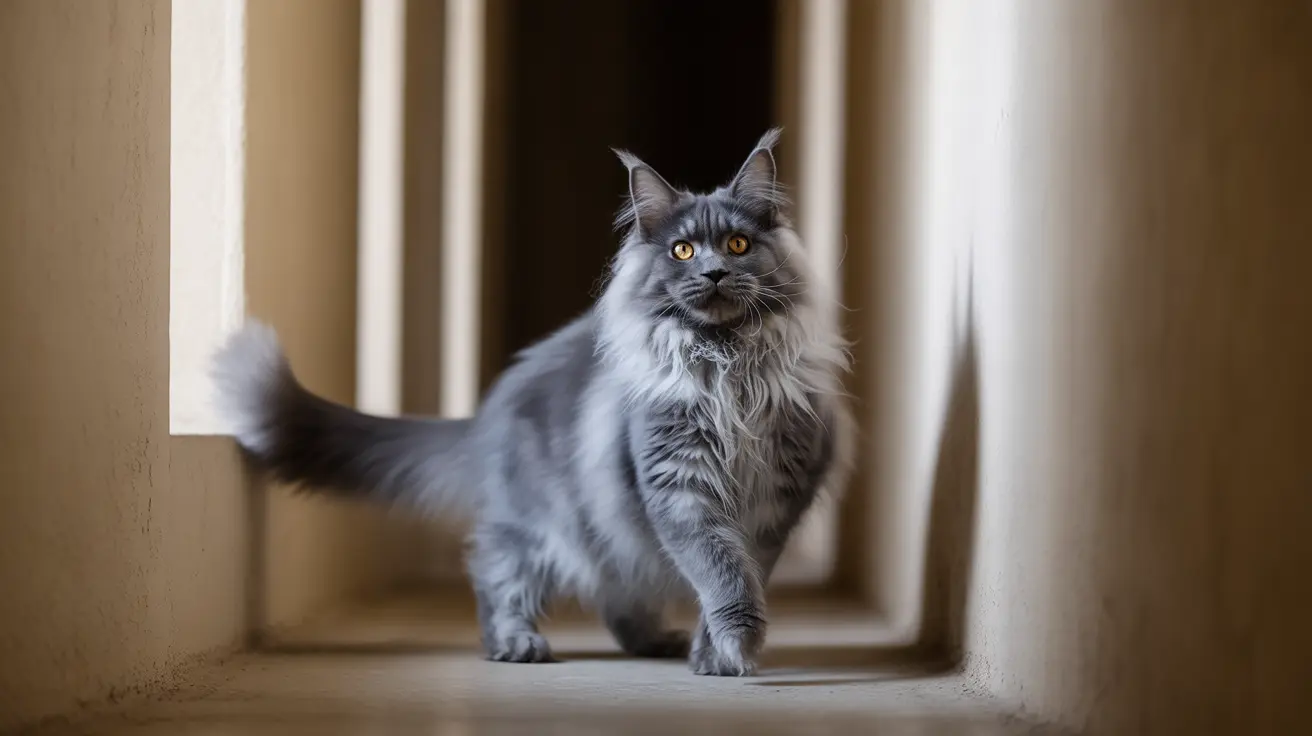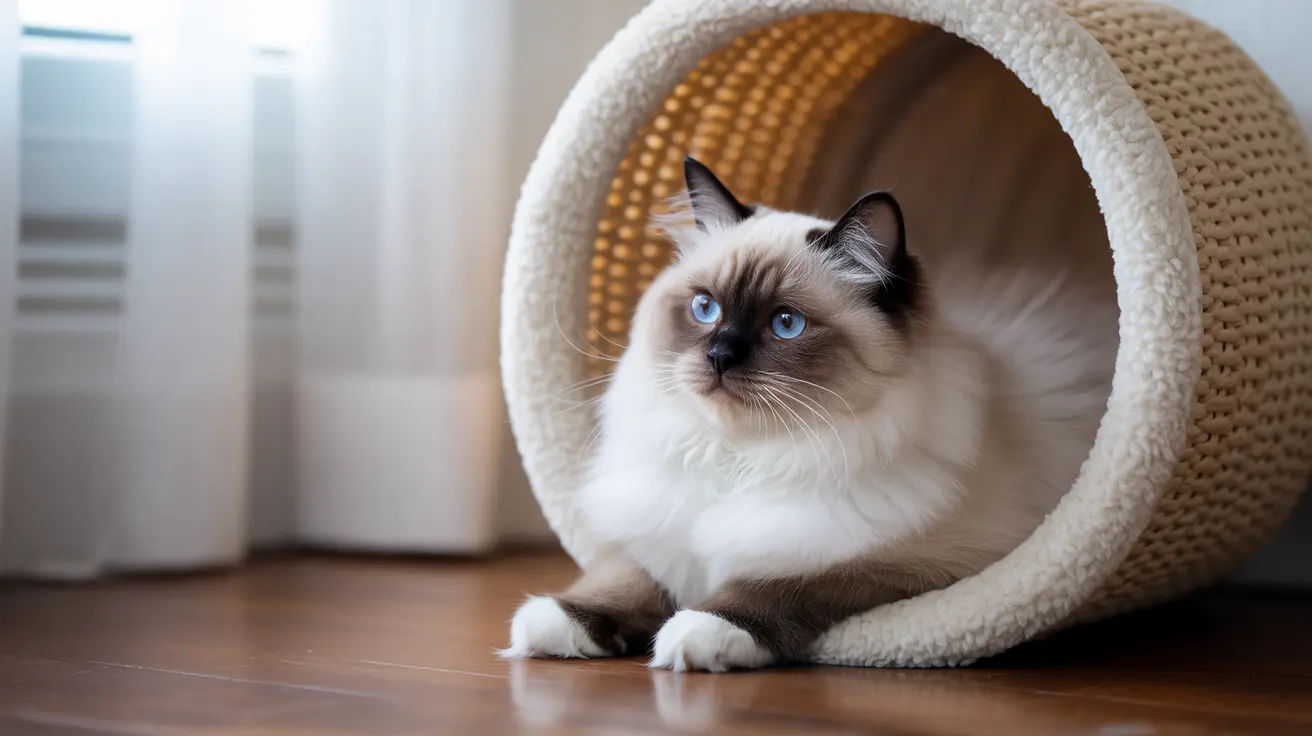Why Do Cats Seem Sneaky: Understanding Your Feline's Natural Instincts
If you've ever caught your cat silently stalking through the house, hiding behind furniture, or suddenly pouncing from seemingly nowhere, you might wonder why cats seem sneaky. The truth is, cats aren't being malicious or deceitful—their seemingly sneaky behavior is actually a fascinating display of millions of years of evolutionary programming at work.
Understanding why cats seem sneaky requires looking beyond surface behaviors to the deep-rooted instincts that drive every feline action. These behaviors, which might appear mysterious or mischievous to us, are actually sophisticated survival strategies that have helped cats thrive as both predators and prey throughout their evolutionary history.
This comprehensive guide will explore the fascinating world of feline behavior, debunk common misconceptions about cat sneakiness, and provide practical insights for cat owners who want to better understand and support their pet's natural instincts.
The Evolutionary Foundation of Feline Stealth
To understand why cats seem sneaky, we must first appreciate that cats are natural-born hunters with physical and behavioral traits evolved specifically for stealth, agility, and careful movement. This stealthy behavior is rooted in millions of years of evolution, serving cats both as efficient predators and as potential prey to larger animals.
Cats possess remarkable physical adaptations that enable their sneaky behavior. Their padded paws naturally muffle footsteps, allowing them to move virtually silently across various surfaces. Additionally, their flexible spines enable fluid, graceful movement that appears almost supernatural to human observers. Even domestic cats retain these powerful instincts despite not needing to hunt for survival in our homes, which explains why sneaky behavior remains such an integral part of their nature.
Physical Adaptations That Enable Stealth
The feline body is essentially a perfect stealth machine. Beyond their padded paws and flexible spines, cats have retractable claws that remain sharp and silent when walking, and their whiskers serve as sensitive radar systems that help them navigate in darkness without making noise. These physical traits work together to create the impression that cats are inherently sneaky, when in reality, they're simply utilizing their natural evolutionary advantages.
The Dual Nature: Predator and Prey Instincts
One of the most important factors in understanding why cats seem sneaky is recognizing that domestic cats exist in a unique position—they are both predators and prey. This dual nature profoundly influences their behavior and explains many of the sneaky behaviors that cat owners observe daily.
As predators, cats use sneaking to stalk and pounce, practicing their hunting skills on toys, shadows, or even during play with their human companions. This predatory behavior helps satisfy their natural drive to hunt, even when they're well-fed house cats. However, domestic cats also retain strong prey instincts because they need to avoid larger predators like coyotes, foxes, and birds of prey in outdoor environments. Their cautious and secretive behavior serves as a crucial survival mechanism that helps them stay safe.
Territorial Surveillance and Social Awareness
Cats use stealth not only for hunting but also for territorial surveillance and social monitoring. They move quietly through their environment to observe and gather information, allowing them to avoid confrontation while maintaining control over their territory. This behavior explains why cats often appear to sneak around corners or peek around doorways—they're simply conducting their natural security patrols.
Common "Sneaky" Behaviors Explained
Many behaviors that cat owners interpret as sneaky are actually perfectly normal expressions of feline instincts. Understanding the true motivations behind these behaviors can help owners better appreciate their cats' natural needs and respond appropriately.
Curiosity and Exploration
Cats are naturally curious animals that cautiously explore new environments or objects. What might appear as sneaky behavior is often methodical investigation—cats prefer to approach new situations carefully, using all their senses to gather information before fully committing to interaction. This cautious approach helps them assess potential threats or opportunities in their environment.
Play Behavior and Mock Hunting
Sneaking and hiding often manifest as play behavior that replicates hunting sequences. Cats may hide before pouncing on toys, family members' feet, or shadows on the wall. This play behavior is crucial for their mental and physical health, allowing them to practice and maintain their natural hunting skills even in a domestic environment.
Self-Preservation Responses
When cats feel threatened, uncertain, or overwhelmed, sneaky behavior becomes a self-preservation strategy. Moving stealthily allows them to retreat quickly and avoid detection when they perceive danger or stress. This explains why cats might suddenly become more secretive during periods of change, such as moving to a new home or the introduction of new family members.
The Psychology Behind Hiding Behavior
Hiding is perhaps the most misunderstood aspect of feline behavior. While owners might interpret hiding as antisocial or problematic behavior, it actually serves several important psychological and physiological functions for cats.
Cats hide to feel safe from potential predators and stressful stimuli in their environment. Even as efficient predators themselves, small domestic cats retain strong prey instincts, making hiding their primary defense mechanism. These hiding spots also provide cats with quiet, secure places for rest and observation, allowing them to monitor their surroundings while feeling protected.
Preferred Hiding Locations
Cats consistently choose hiding spots that offer specific advantages: they prefer locations that are secluded, elevated when possible, covered or enclosed, and positioned away from high-traffic areas like food or litter locations. Common favorites include cardboard boxes, paper bags, closets, under furniture, and specialized cat hiding products like tunnels and cave beds.
Environmental Factors That Influence Sneaky Behavior
The domestic environment can significantly affect how cats express their natural sneaky behaviors. Understanding these environmental influences can help cat owners create spaces that support their pets' psychological needs while minimizing problematic behaviors.
Lack of Appropriate Outlets
When cats don't have adequate opportunities to express their natural hunting and hiding instincts, they may develop more pronounced sneaky behaviors or redirect these instincts in unwanted ways. Providing appropriate outlets through environmental enrichment is crucial for maintaining behavioral balance.
Stress and Environmental Changes
Changes in the household environment, such as new pets, moving furniture, or altered routines, can trigger increased sneaky behavior as cats attempt to navigate and understand their modified territory. During these periods, cats may become more secretive as they assess and adapt to changes.
Health Implications of Behavioral Changes
While normal sneaky behavior is part of healthy feline psychology, sudden changes in hiding patterns or stealth behavior can indicate underlying health problems. Attentive observation by owners is crucial for identifying when normal sneakiness becomes a potential health concern.
Increased hiding, withdrawal from normal activities, or significant behavioral shifts may signal illness, pain, or anxiety. Signs that warrant veterinary evaluation include changes in activity levels, appetite, social interaction, or excessive hiding that represents a departure from the cat's normal behavior patterns.
When to Seek Professional Help
Cat owners should consult with veterinarians when they observe sudden increases in hiding behavior, withdrawal from previously enjoyed activities, changes in eating or drinking patterns, or any combination of behavioral changes that seem out of character for their individual cat.
Creating an Enriching Environment
Supporting cats' natural sneaky instincts requires thoughtful environmental design that provides appropriate outlets for hunting, hiding, and exploration behaviors. Successful environmental enrichment acknowledges and works with feline nature rather than against it.
Essential Environmental Features
Effective cat environments include multiple hiding spots at various heights, interactive toys that simulate prey behavior, climbing structures that satisfy territorial instincts, and quiet retreat areas where cats can observe without being disturbed. Specialized products like collapsible cat tunnels, cardboard cubbies, cat cave beds, and elevated cubby boxes offer secure, comfortable spaces for natural behaviors.
Play and Exercise Opportunities
Providing regular interactive play sessions that mimic hunting sequences helps satisfy cats' predatory instincts in appropriate ways. Toys that encourage stalking, pouncing, and capturing behaviors can reduce the likelihood that cats will redirect these instincts toward inappropriate targets or develop behavioral problems from frustrated natural drives.
Safety Considerations for Sneaky Cats
While supporting natural sneaky behavior is important, cat owners must also consider safety implications. Cats' tendency to hide and explore can sometimes lead them into dangerous situations that require preventive measures.
Common safety concerns include cats hiding in appliances like washers and dryers, car engines, or small spaces where they might become trapped. Owners should develop habits of checking these areas before use and ensuring that cats have access to safe alternatives that satisfy their hiding instincts without creating risk.
Breed and Age Variations in Sneaky Behavior
Different cat breeds and life stages can exhibit variations in sneaky behavior expression. Understanding these differences helps owners set appropriate expectations and respond to their individual cat's needs.
Some breeds may be naturally more active in their sneaky behaviors, while others might be more sedentary in their approach to territory monitoring. Similarly, kittens, adult cats, and senior cats may express sneaky instincts differently based on their energy levels, physical capabilities, and life experience.
Debunking Common Misconceptions
Many misconceptions persist about why cats seem sneaky, often attributing human motivations to feline behavior. It's important to understand that cats' actions are not morally driven—cats are intelligent animals, but they are not intentionally deceitful or malicious in the way humans might interpret their behavior.
Experts consistently emphasize that typical cat behaviors such as sneaking, sudden attacks during play, or vocal demands are instinctive survival strategies rather than signs of malice or deliberate sneakiness. Understanding this distinction helps cat owners develop more appropriate responses to their pets' natural behaviors.
Building a Stronger Human-Cat Bond
Understanding and supporting cats' natural sneaky instincts can significantly strengthen the relationship between cats and their human companions. When owners appreciate the evolutionary logic behind feline behavior, they can respond more appropriately and create environments that support their cats' psychological well-being.
Rather than viewing sneaky behavior as problematic, owners can learn to see it as an expression of their cat's healthy natural instincts. This perspective shift often leads to more successful management strategies and greater appreciation for feline intelligence and adaptability.
Frequently Asked Questions
- Why do cats hide and then try to scare you? This behavior is typically playful expression of hunting instincts rather than an attempt to frighten. Cats hiding and then jumping at their owners is usually play behavior tied to their natural predatory sequences, though excessive hunting behavior toward humans may suggest frustration or redirected aggression that might benefit from veterinary consultation.
- Why has my cat started hiding suddenly? Sudden increases in hiding behavior can indicate behavioral or medical problems. Stress from environmental changes, illness, pain, or anxiety can all trigger increased hiding. A veterinary examination can help identify underlying issues and determine appropriate treatment or management strategies.
- Why do cats sneak into rooms just to sniff around and leave? Cats are naturally curious animals that use scent to gather detailed information about their surroundings and the people in their home. This behavior represents normal territorial monitoring and social awareness, as cats rely heavily on scent-based communication and environmental assessment.
- Why do cats feel the need to sneak outside even when doors are open? Cats combine both predator and prey instincts when approaching open doorways. They approach cautiously to assess potential threats and gather environmental information through all their senses before committing to movement, which helps maintain their safety in potentially unpredictable outdoor environments.
- How can I help a cat that hides excessively? Ensure your cat has comfortable, safe hiding places that meet their psychological needs while monitoring for signs of illness or stress. If hiding behavior increases significantly or is accompanied by other behavioral changes, consult with a veterinarian to rule out medical causes and develop appropriate management strategies.
- Is sneaky behavior different among various cat breeds? While all cats share basic evolutionary instincts for stealth and hiding, individual cats and different breeds may express these behaviors with varying intensity based on their genetics, personality, and energy levels. Some breeds may be more active in their territorial monitoring, while others might be more subtle in their approach.
- What environmental enrichments best support natural sneaky behavior? Effective environmental enrichment includes multiple hiding spots at different heights, interactive toys that simulate prey behavior, climbing structures, cat tunnels, cardboard boxes, and quiet retreat areas. The key is providing appropriate outlets for hunting, hiding, and exploration instincts in safe, controlled ways.
Conclusion
Understanding why cats seem sneaky reveals the fascinating complexity of feline behavior and the remarkable evolutionary adaptations that make cats such successful survivors. Rather than viewing sneaky behavior as mysterious or problematic, cat owners can appreciate these behaviors as expressions of sophisticated natural instincts that have served cats well for millions of years.
By providing appropriate environmental enrichment, monitoring for health-related behavioral changes, and respecting cats' natural need for stealth and hiding, owners can support their pets' psychological well-being while strengthening the human-animal bond. Remember that your cat's sneaky behavior is not a sign of deception or malice—it's a testament to the remarkable evolutionary heritage that makes cats such fascinating and adaptable companions.






